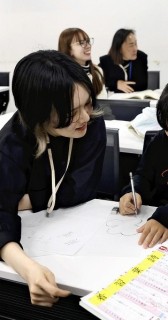Loading
Search
▼ University Students Fill Key Role in Teaching Japanese to Foreign Children, as Japan Welcomes More Workers from Abroad
- Category:Other
More and more university students are teaching children with foreign roots the Japanese language, and working to create places for them to feel comfortable.
Amid a shortage of teachers for Japanese as a second language, students studying Japanese language education at universities are working actively in the field, and putting what they have learned into practice.
Club activities
“Yu-bin-u-ke. Do you know what that means?”
In mid-April in a classroom at Toyo University in Bunkyo Ward, Tokyo, a senior at the university pointed at a Japanese language textbook and began drawing a picture of a mailbox on a sheet of paper with a felt-tip pen.
A boy of Chinese nationality in the second grade of elementary school, who was reading the textbook with her, nodded his head in understanding at her drawing.
The university club Spirit, which she heads, holds a Japanese class for children of foreign nationalities every week.
On the day, four Chinese and Australian children were participating in the class. Using simple Japanese, occasionally employing Chinese and English, the university students asked the children about what they did at their schools and helped them with their homework.
“Since we’re university students and closer in age to them, they should be able to talk to us about things. We want to make this a place where children can resolve problems they may have at school,” the leader of Spirit said about the purpose of the club’s activities.
Too few teachers
At the University of Tsukuba in Tsukuba, Ibaraki Prefecture, students studying Japanese language education have been helping with Japanese classes at junior high schools in the prefecture since fiscal 2020.
The prefecture’s student body has grown more diverse in terms of nationalities, but the foreign students are spread out, making it difficult for schools to hire enough teachers who can teach Japanese as a second language.
Last academic year, about 30 university students supported a total of 51 students enrolled at 24 junior high schools, assessing how the non-native speakers did in the classroom, determining their level of Japanese, and working out what they should study.
When the children received Japanese lessons in a separate room, the university students joined in online, explaining the terms used in the lesson and acting as partners in speaking practice.
At Hokota Kita Junior High School, a municipal school in the prefecture’s city of Hokota, a Pakistani boy received support from university students and successfully went on to a local high school this spring.
The principal of the school recalled, “When the student entered our school, he could hardly speak Japanese. There were no teachers who could instruct him, but the university students saved us.”
“The university students also gain a lot from the program, as it provides them with an opportunity to practice teaching the Japanese language,” said Hiroko Sawada, 49, an associate professor at the University of Tsukuba, who is in charge of the program to help children in need of language support.
Josai International University in Togane, Chiba Prefecture, which has a course for teaching Japanese as a foreign language, concluded a partnership agreement with the city of Sammu in the prefecture in 2023.
The Sri Lankan population in Sammu has been growing quickly, and this academic year there are 88 foreign students, double the figure four years ago.
The university provides advice to teachers who instruct such children in Japanese, and also creates opportunities for exchange between university students and the children.
Rising demand
Japan had about 3.76 million foreign residents at the end of last year, according to the Immigration Services Agency. That number is up by about 1.64 million over the past 10 years, with the government accepting more foreign workers to try to remedy a labor shortage.
In fiscal 2023, students who were enrolled in public elementary, junior high and high schools and needed Japanese lessons totaled about 69,000, according to a survey by the Ministry of Education, Culture, Sports, Science and Technology.
This was about 11,000 more students than in the previous survey conducted in fiscal 2021, extending a record high.
The education ministry plans to improve support for students of foreign nationalities by assigning one teacher for every 18 students in need of Japanese lessons by fiscal 2026.
“The national government should assume responsibility for the education of these children, because it intends to increase acceptance of foreigners,” said Hiromi Saito, 63, a professor at Tokyo Gakugei University who is an expert on Japanese language education.
“Meanwhile, it is important for external staff, such as university students, to be made use of as supporters rather than simply as a stopgap measure to fill in for teachers.”
- April 21, 2025
- Comment (0)
- Trackback(0)


